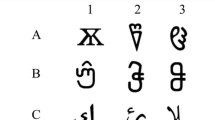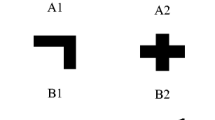Abstract
In this study, 12 5-year-old normal functioning children were exposed to a respondent-type training procedure and tested for emergent conditional discriminations. During respondent-type training, arbitrary stimuli were presented in pairs, one at a time, using a table-top procedure. On a given trial, for example, the arbitrary stimulus A1 was presented on an observation card for 1 s, followed by the arbitrary stimulus B1 presented on another observation card for 1 s (represented as A1→B1), Emergent conditional discriminations were tested using a standard matching-to-sample procedure. On one test trial, for example, B1 was presented as a sample, with A1 and A2 as comparisons. Choosing A1 (rather than A2) was defined as the correct choice (represented as B1-A1), based on the previous respondent-type training (A1→B1). In Experiment 1 (linear condition), subjects were trained and tested in the following sequence: train A1→B1, A2→B2, testB1-A1, B2-A2; train B1→C1, B2→C2, test C1-B1, C2-B2, C1-A1, C2-A2; train C1→D1, C2→D2, test D1-B1, D2-B2, D1-A1, D2-A2. In Experiment 2 (one-to-many condition), subjects were trained and tested in the following sequence: train B1→A1, B2→A2, test A1-B1, A2-B2; train B1→C1, B2→C2, test C1-B1, C2-B2, C1-A1, C2-A2; train B1→D1, B2→D2, test D1-C1, D2-C2, D1-A1, D2-A2. In Experiment 3 (many-to-one condition), subjects were trained and tested in the following sequence: train A1→B1, A2→B2, test B1-A1, B2-A2; train C1→B1, C2→B2, test B1-C1, B2-C2, C1-A1, C2-A2; train D1→B1, D2→B2, test D1-C1, D2-C2.D1-A1, D2-A2. The study demonstrated that respondent-type training is an effective means of generating equivalence classes with young children. Results also showed that it is possible to extend an equivalence class using the respondent procedure without testing for the “mediating” symmetry relations. The training protocols (linear, one-to-many, and many-to-one) were found to be equally effective, although a possible ceiling effect needs to be taken into account.
Similar content being viewed by others
References
BARNES, D. (1994). Stimulus equivalence and relational frame theory. The Psychological Record. 44, 91–124.
BARNES, D., & Holmes. Y. (1991). Radical behaviorism, stimulus equivalence, and human cognition. The Psychological Record, 41, 19–31.
BARNES-HOLMES, D., & BARNES-HOLMES, Y. (in press) Explaining complex behavior; Two perspectives on the concept of generalized operant classes. The Psychological Record.
BARNES-HOLMES, D.. HAYES, S. C., HEGARTY, N., & DYMOND, S. (in press). Multiple stimulus relations, the transformation of stimulus functions, and the limits of the class concept, In S. C. Hayes & D. Barnes-Holmes (Eds.), Relational frame theory: Creating an alternative behavioral agenda in language and cognition. Reno, NV: Context Press.
BARNES-HOLMES, D., HEALY O., & HAVES. S. C. (in press). Relational frame theory and the relational evaluation procedure; Approaching human language as derived relational responding, In D. E. Blackman & J. C. Leslie (Eds.) Empirical and conceptual issues in behavior analysis. Reno, NV: Context Press.
HAYES, S. C. & BARNES, D. (1997). Analyzing derived stimulus relations requires more than the concept of stimulus class. Journal of the Experimental Analysis of Behavior, 68, 235–244.
HAYES, S. C. & HAYES, L. J. (1969). The verbal action of the listener as the basis for rule governance. In S. C. Hayes (Eds.), Rufe governed behavior: Cognition contingencies and instructional control (pp. 153–190). New York: Plenum Press.
HORNE, P., & LOWE, C. F. (1996). On the origins of naming and other symbolic behavior. Journal of the Experimental Analysis of Behavior. 65, 105–242.
HORNE, P., & LOWE, C. F. (1997). Toward a theory of verbal behavior. Journal of the Experimental Analysis of Behavior. 68, 271–296.
LEADER, G., BARNES. D., & SMEETS, P. M. (1996). Establishing equivalence relations using a respondent-type training procedure. The Psychological Record, 46, 685–706.
SAUNDERS, R. R., SAUNDERS, K. J., KIRBY, K. C., & SPRADLIN. J. E. (1988). The merger and development of equivalence classes by unreinforced conditional selection of comparison stimuli. Journal of the Experimental Analysis of Behavior, 50, 145–162.
SMEETS, P. M., LEADER, G., & BARNES. D. (1997). Establishing stimulus classes in adults and children using a respondent-type training procedure: A follow-up study. The Psychological Record, 47, 285–308.
SPRADLIN, J. E., & SAUNDERS, R. R. (1986). The development of stimulus classes using matching-to-sample procedures: Sample classification versus comparison classification. Analysis and Intervention in Developmental Disabilities, 6, 41–58.
URCUIOLI, P. J., & ZENTALL, T. R. (1993). A test of comparison-stimulus substitutability following one-to-many matching by pigeons. The Psychological Record, 43, 745–759.
ZENTALL, T. R., & URCUIOLI, P. J. (1993). Emergent relations in the formation of stimulus classes by pigeons. The Psychological Record, 43, 539–544.
Author information
Authors and Affiliations
Corresponding author
Rights and permissions
About this article
Cite this article
Leader, G., Barnes-Holmes, D. & Smeets, P.M. Establishing Equivalence Relations Using a Respondent-Type Training Procedure III. Psychol Rec 50, 63–78 (2000). https://doi.org/10.1007/BF03395343
Published:
Issue Date:
DOI: https://doi.org/10.1007/BF03395343




